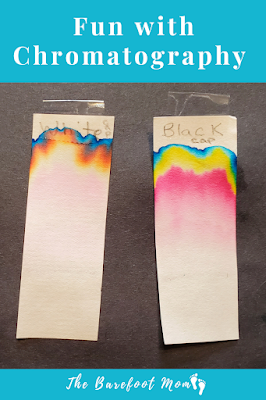What is Chromatography?
Chromatography is a laboratory technique used to separate the components of a mixture. Typically the mixture is moved along a stationary material like gelatin or paper by a liquid or gas carrier. The different components of the mixture are deposited back on the material at different rates, thus seperating them for analysis.
It sounds complicated, but you can do some simple paper chromatography easily at home with coffee filters and markers.
Basic Paper Chromatography Experiment
For this activity you will need:
-A coffee filter
-Scissors
-Washable markers of several different colors. Black and brown markers tend to work best. Try several different brands.
-A few small cups
-Tape
-A few pencils
Marker ink is often made up of several different pigments, especially the darker colors like blacks and browns. Using a simple paper chromatography technique you can separate these pigments so that you can actually see them individually.
Start by cutting the coffee filter into several long rectangle strips, about an inch wide and 4 inches long.
On each strip draw a line from side to side about a half an inch from the bottom with the markers. Use a different marker for each strip. Label each strip at the top with pencil so that you know which marker was used on each strip.
Using a small piece of tape, attach the top of each coffee filter strip to the center of a pencil.
Add enough water to each cup so that when you set one of the pencils across the top, the paper strip will just barely touch the water. Be sure that the water line is below the line you drew with the marker.
Then watch as the water is slowly absorbed up the paper. As it passes the spot where you made your line with the marker, you will see the different pigments start to separate as they are carried by the water up the coffee filter.
When the water has finished climbing the coffee filter, remove it from the cup and let it dry. Compare the different pigments in different colored pens and different brands.
So what exactly happened? Since the ink is washable, it's water soluble, and was picked up by the water as it passed over it. The individual pigments were then redeposited on the paper based on how attracted they are to it. This caused the pigments to separate leaving bands of different colors on the paper.
You can learn more about how paper chromatography works with this video from Kahn Academy: Basics of Chromatography.
Mystery Ink Paper Chromatography Activity
Set up the same basic chromatography experiment as above, but choose one marker ahead of time and use it to draw a line about 1/2 inch from the bottom of one of the coffee filter strips. Take note of which marker you used, but don't tell anyone else. Label this strip with a question mark.
Have your kids run chromatography tests on all the markers and challenge them to use the results to determine which pen was used to make your mystery line.
Paper Chromatography Flowers
You can use this same chromatography technique to make beautiful paper flowers!
For this activity you will need:
-Coffee filters
-Markers (I recommend using the ones that gave you the best results in the basic chromatography experiment)
-Green pipe cleaners
-Several small cups
Instead of cutting the coffee filters into strips leave them whole this time. Draw a thick circle around the center of your coffee filter with one of the markers like in the photo below.
Then fold your coffee filter like this:
Set the bottom of the coffee filter into a small cup of water with about 1/4 inch of water in the bottom. Be sure the water is lower than your marker line.
Watch as the water is absorbed and sperates the pigments, coloring the coffee filter.
Remove the coffee filter from the cup, gently unfold it, and set it aside to dry.
Repeat with the other coffee filters.
When your coffee filters are dry bunch them into paper flowers and add green pipe cleaners as stems.
Fall Leaf Chromotagraphy
Shred up several leaves of the same type and put them in a small cup, then mash them up a bit with the back of a spoon.
Add a couple tablespoons of rubbing alcohol and cover with plastic wrap. Repeat this process with the other types of leaves you collected. Then set the cups aside over night.
The next day, remove the plastic wrap from the cups. The rubbing alcohol should look colored from the leaves.
Cut a coffee filter into strips about an inch wide and about 4 inches long. Set one end of a coffee filter strip into each cup and watch as the rubbing alcohol is absorbed up the coffee filter strip.
After about 20-30 minutes, remove the coffee filter strips and set them some place to dry. You should see bands of different colors on the strips. These are the different pigments in the leaves.












Comments
Post a Comment